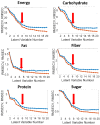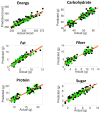Rapid Determination of Nutritional Parameters of Pasta/Sauce Blends by Handheld Near-Infrared Spectroscopy
- PMID: 31141878
- PMCID: PMC6601008
- DOI: 10.3390/molecules24112029
Rapid Determination of Nutritional Parameters of Pasta/Sauce Blends by Handheld Near-Infrared Spectroscopy
Abstract
Nowadays, near infrared (NIR) spectroscopy has experienced a rapid progress in miniaturization (instruments < 100 g are presently available), and the price for handheld systems has reached the < $500 level for high lot sizes. Thus, the stage is set for NIR spectroscopy to become the technique of choice for food and beverage testing, not only in industry but also as a consumer application. However, contrary to the (in our opinion) exaggerated claims of some direct-to-consumer companies regarding the performance of their "food scanners" with "cloud evaluation of big data", the present publication will demonstrate realistic analytical data derived from the development of partial least squares (PLS) calibration models for six different nutritional parameters (energy, protein, fat, carbohydrates, sugar, and fiber) based on the NIR spectra of a broad range of different pasta/sauce blends recorded with a handheld instrument. The prediction performance of the PLS calibration models for the individual parameters was double-checked by cross-validation (CV) and test-set validation. The results obtained suggest that in the near future consumers will be able to predict the nutritional parameters of their meals by using handheld NIR spectroscopy under every-day life conditions.
Keywords: handheld near-infrared spectroscopy; nutritional parameters; partial least squares calibration; pasta/sauce blends.
Conflict of interest statement
The authors declare no conflict of interest.
Figures





 ), prediction fit (
), prediction fit ( ), calibration samples (
), calibration samples ( ) and predicted test set samples (
) and predicted test set samples ( )).
)).Similar articles
-
Quantitative analysis of a pharmaceutical formulation: Performance comparison of different handheld near-infrared spectrometers.J Pharm Biomed Anal. 2018 Oct 25;160:179-186. doi: 10.1016/j.jpba.2018.07.048. Epub 2018 Jul 30. J Pharm Biomed Anal. 2018. PMID: 30096648
-
The potential of near infrared spectroscopy to estimate the content of cannabinoids in Cannabis sativa L.: A comparative study.Talanta. 2018 Dec 1;190:147-157. doi: 10.1016/j.talanta.2018.07.085. Epub 2018 Jul 27. Talanta. 2018. PMID: 30172491
-
Calibration sets selection strategy for the construction of robust PLS models for prediction of biodiesel/diesel blends physico-chemical properties using NIR spectroscopy.Spectrochim Acta A Mol Biomol Spectrosc. 2017 Jun 5;180:119-126. doi: 10.1016/j.saa.2017.03.008. Epub 2017 Mar 3. Spectrochim Acta A Mol Biomol Spectrosc. 2017. PMID: 28284157
-
[Application of near infrared reflectance spectroscopy to predict meat chemical compositions: a review].Guang Pu Xue Yu Guang Pu Fen Xi. 2013 Nov;33(11):3002-9. Guang Pu Xue Yu Guang Pu Fen Xi. 2013. PMID: 24555369 Review. Chinese.
-
Spectral Encoder to Extract the Features of Near-Infrared Spectra for Multivariate Calibration.J Chem Inf Model. 2022 Aug 22;62(16):3695-3703. doi: 10.1021/acs.jcim.2c00786. Epub 2022 Aug 2. J Chem Inf Model. 2022. PMID: 35916486 Review.
Cited by
-
Advances in Near-Infrared Spectroscopy and Related Computational Methods.Molecules. 2019 Nov 29;24(23):4370. doi: 10.3390/molecules24234370. Molecules. 2019. PMID: 31795360 Free PMC article.
-
Miniaturized NIR Spectroscopy in Food Analysis and Quality Control: Promises, Challenges, and Perspectives.Foods. 2022 May 18;11(10):1465. doi: 10.3390/foods11101465. Foods. 2022. PMID: 35627034 Free PMC article. Review.
-
Quantification of Water, Protein and Soluble Sugar in Mulberry Leaves Using a Handheld Near-Infrared Spectrometer and Multivariate Analysis.Molecules. 2019 Dec 4;24(24):4439. doi: 10.3390/molecules24244439. Molecules. 2019. PMID: 31817211 Free PMC article.
-
Principles and Applications of Miniaturized Near-Infrared (NIR) Spectrometers.Chemistry. 2021 Jan 21;27(5):1514-1532. doi: 10.1002/chem.202002838. Epub 2020 Oct 29. Chemistry. 2021. PMID: 32820844 Free PMC article. Review.
-
QCM Sensor Arrays, Electroanalytical Techniques and NIR Spectroscopy Coupled to Multivariate Analysis for Quality Assessment of Food Products, Raw Materials, Ingredients and Foodborne Pathogen Detection: Challenges and Breakthroughs.Sensors (Basel). 2020 Dec 7;20(23):6982. doi: 10.3390/s20236982. Sensors (Basel). 2020. PMID: 33297345 Free PMC article. Review.
References
-
- Sorak D., Herberholz L., Iwascek S., Altinpinar S., Pfeifer F., Siesler H.W. New developments and applications of handheld raman, mid-infrared, and near-infrared spectrometers. Appl. Spectrosc. Rev. 2012;47:83–115.
-
- Guillemain A., Dégardin K., Roggo Y. Performance of NIR handheld spectrometers for the detection of counterfeit tablets. Talanta. 2017;165:632–640. - PubMed
-
- Yakes B.J., Brückner L., Karunathilaka S.R., Mossoba M.M., He K. First use of handheld Raman spectroscopic devices and on-board chemometric analysis for the detection of milk powder adulteration. Food Control. 2018;92:137–146.
MeSH terms
Grants and funding
LinkOut - more resources
Full Text Sources
Miscellaneous

